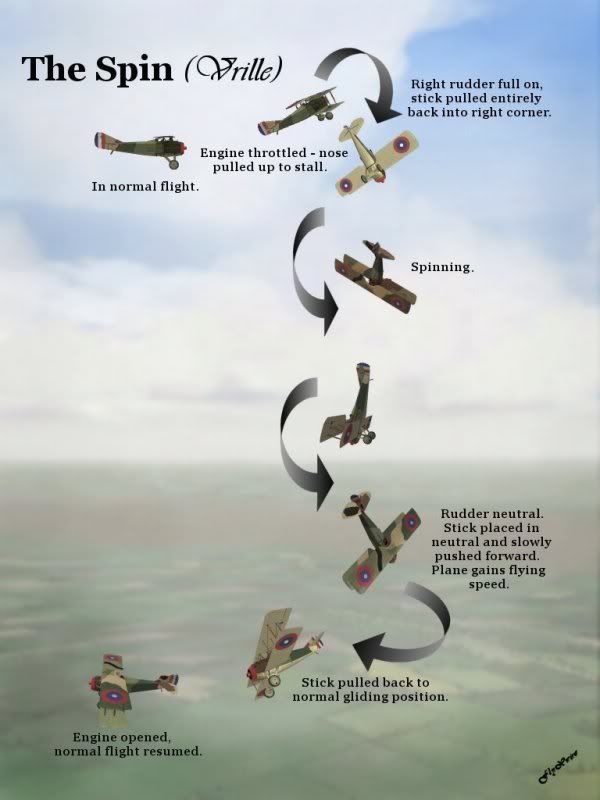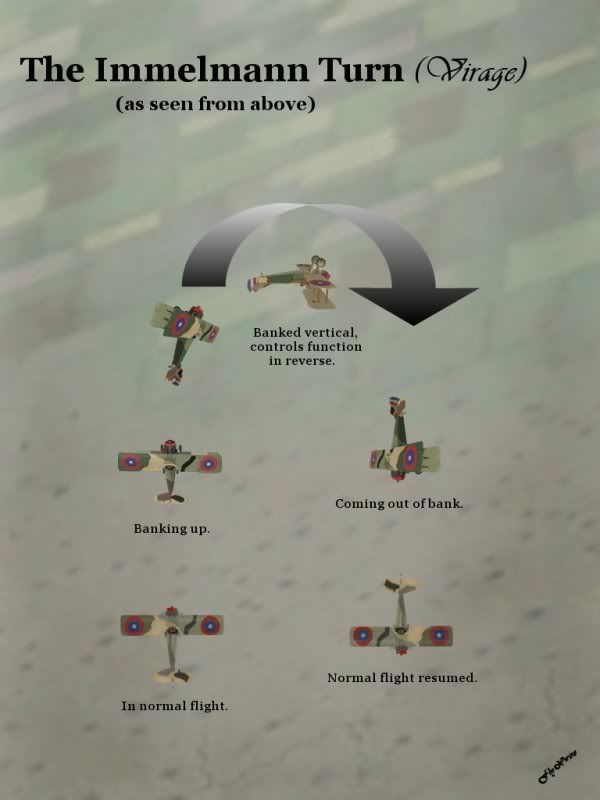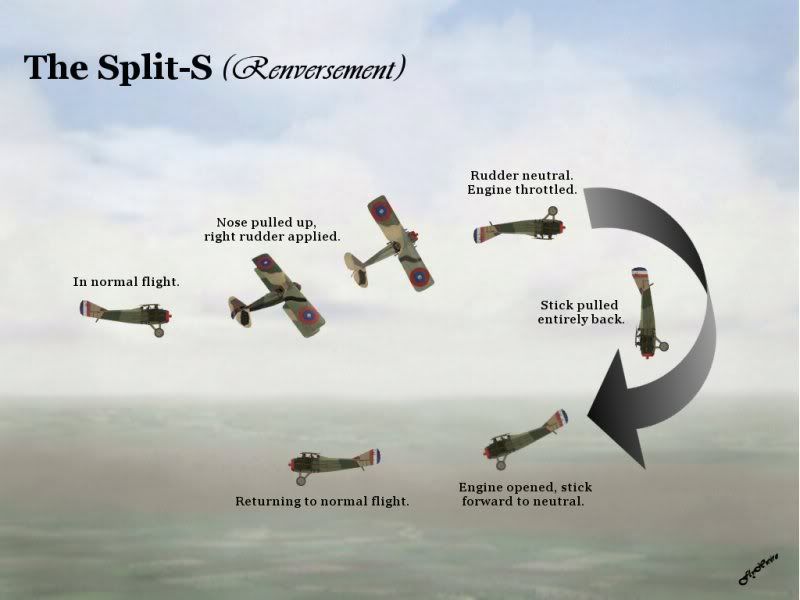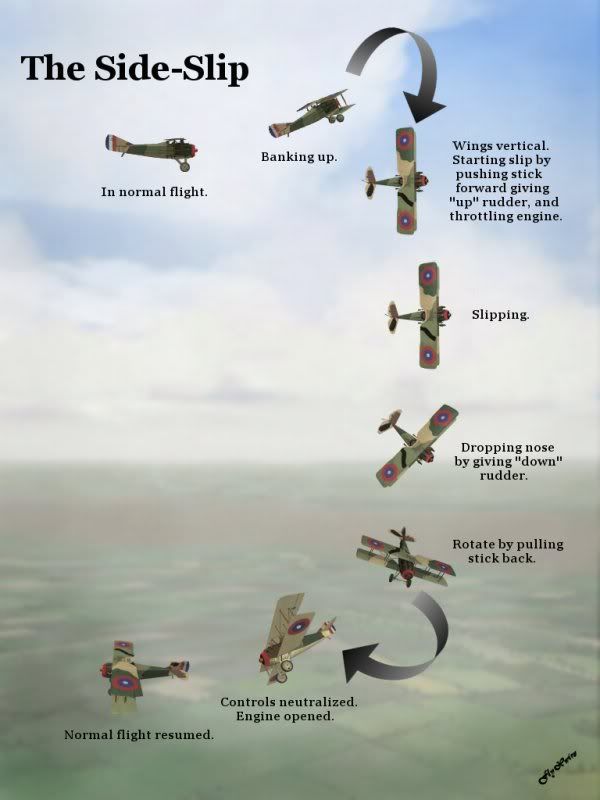Hi guys,
I figured readers of the SDOE forum here, and fans of FS-WWI might be interested in reading an article I worked-up on American pilot training in advanced aerobatics during the Great War:
In June of 1917, Lieuntenant Albert Louis Deullin of the
Aviation Militaire wrote down the principles he had learned from combat fighting as a
chasse pilot and leader in his "Pursuit Work in a Single-Seater". These ideas were adopted by the United States Army Air Service, and Deullin's doctrine became a part of the "French System" of instruction that American pilots received at their training fields in France. In the matters of airmanship, the Deullin monograph had the following to say about mastering the techniques of aerobatic maneuver:
As a pilot, he should be, before everything else, skillful in maneuvering. He can never practice too much aerial acrobatics; the short turn without change of height, climbing and descending spirals, nose spins, renversements," "retournements," looping the loop, short climbs at a very steep angle (What is known as a "chandelle" in French is the maneuver executed, when a plane has acquired an excessive speed in a dive, by pulling the plane into an angle greater than the best climbing angle. By using full motor a very steep ascent may thus be made until the machine begins to lose its speed, when a more normal angle is adopted. The height which can be gained in this manner will of course depend upon the machine and the amount of excess speed at the beginning of the ascent), dives and so on are the beginning of his period of instruction. He will only be ready for the "chasse" when he can execute them with precision relative to an adversary who manoeuvres likewise.When Lieutenant-Colonel Hiram Bingham (renowned explorer of S. America, and eventual U.S. Senator) assumed command of the Third Aviation Instruction Center at Issoudun, France in the spring of 1918, the training of American airmen at the sprawling complex had been under way for many months. Although some streamlining of the "French System" of training was to take place, the American Air Service largely maintained the syllabus as originally set forth, and in his book
An Explorer in the Air Service, Bingham described the daily routine that pilots experienced in their effort to qualify as single-seater or two-seater airmen at Issoudun. Much of the following details on aerobatic maneuver comes from Bingham's book and drawings, and his references as to the manner of service instruction conducted at the Center's various airfields was invaluable in preparing this article.
One of the first advanced maneuvers that American airmen trained on, was how to initiate and recover from a spin, or as the French called it the
Vrille. For reasons that became obvious as the war progressed, it was deemed imperative that pilots learned how to master the spin as part of their basic training, before more advanced instruction continued. In letters home, Lt. Waldo Heinrichs describes doing a
Vrille as chronicled in the book
First To The Front, by Charles Woolley:
The first thing on the program was the Vrille, where you pitch with your wings spinning around the fuselage as an axis, very spectacular, but pretty easy so long as you don't lose your head. I climbed up to a thousand meters, cut the engine and after waiting a few seconds to lose speed, I yanked the stick into one comer and kicked the rudder over to the same side. The sensation is more or less like falling over a cliff in a bad dream. You rear up in the air, go over on your back and then start spinning round in a dive. To come out, you straighten your rudder, move the stick back to the center and push it slightly forward until you come out in a dive, when you can pull up the plane, put on the motor again, only it seems as if the earth were still spinning around underneath you.Here's what Bingham wrote about the spin:
The spin or vrille was executed by throttling down the motor, holding up the nose of the plane until its flying speed as almost lost, then kicking the right rudder violently over and pulling the stick sharply back and to the right. This caused the plane to fall immediately into a vrille or "spinning nose dive." In order to come out of the spin, the rudder is at first placed exactly in neutral, then the stick is brought into the neutral position and pushed slowly forward. This causes the plane to stop spinning and start a straight nose dive. After flying speed has been attained by the nose dive, the plane is gradually pulled up to a level flying position and the throttle opened.
The chief danger is that the student in his excitement will over-control and send the plane into a reverse spin or else will push the stick too far forward and turn a somersault, coming out of the spin on his back. Consequently, it was very important to see that the student went up high enough so that he had plenty of room to come out of any positions into which he might get before falling too close to the ground. 
Once proficiency at spirals, and in entering and recovering from a spin was demonstrated by the student pilot, additional instruction in aerobatics continued at Issoudun, with increasingly tighter turns at greater degrees of bank being taught. Next for the budding American pusuit pilots to learn was the Immelmann Turn, or what was encompassed in the French repertoire known as
Virages. Called a "Vertical Virage" because the required bank exceeded 45 degrees, Bingham describes the maneuver's execution technique:
After satisfying the instructor of his ability to do tight spirals, the pilot was next taught to do vertical banks or virages, beginning at an elevation of about five thousand feet. The movements of the controls in this manoeuvre are the same as those in tight spirals, except that the plane is banked over to 90� and the speed is increased to a point where dizziness is brought on very rapidly. 
If the French monitors were satisfied with the progress of their American charges, the student pilots advanced to Fields 5 & 6 at Issoudun, to learn the final two aerobatic maneuvers of their training program, and to fly these in the single-seat Nieuports of 15 Meter wing area, such as the N.21.
Bingham continues with his description of the Split-S:
After this the pilot learned the renversement, the quickest method of doing an aerial "about-face." This manoeuvre is performed by first pulling smartly on the stick and then turning the plane over on its back with a sharp, quick kick on the right rudder, at the same time throttling the motor. Just as the plane comes over on its back, the rudder is kicked sharply back into a neutral position and the stick pulled back into the seat, which causes the plane to come out into a normal glide.In letters written to home, 1st Lieutenant William Muir Russel described his mastering of the
Renversement during his training days at the Center:
The third, which is really beautiful and looks really difficult, but is not, is what the French call a "renversement." This is also very valuable in fighting, as it is the quickest way to turn when being pursued by an enemy. While flying along level you suddenly pull up the nose, let her slip to one side over on her back, then nose her down to the ground and come out going in the opposite direction. All these movements in five seconds. Many beginning to learn this stunt get into the vrille, or tail spin, the first couple of times they try it! It is pretty to watch, and remarkable because no altitude is lost in the maneuver. 
Greatest excitement for Russel, as well as for most other pilots, was reserved for mastering the vertical Side-Slip maneuver, and perhaps understandably so:
In my letter of some time ago, I described the acrobatics which are compulsory for each chasse pilot to take. Our machines have been strengthened to stand the extra strain. All of the sensations are pleasant except the side-slip, where you fall off to one side perpendicularly. This is the worst I have yet encountered, and you may be sure that one does it only when he is ordered to. You are actually torn away from your seat, and your life belt is all that holds you in the machine. At the same time, your stomach rests in your mouth. You can probably understand why the rain is such a friend in need after you have worked for a week endeavoring to perfect such stunts. After satisfying certain French monitors that these maneuvers have been mastered, we were assigned to another field to perfect our squadron flying. This is most interesting work, but a little tedious, as you have to do almost too much flying. Commander Bingham described in his book this final requisite maneuver that aspiring pursuit pilots were to display a capability of performing:
The course of instruction at Field 5 was completed by learning what are known as "wing slips." When once in a wing slip, the plane falls very rapidly sideways and is controlled by a slight pressure on the stick and rudder. To get it into the wing slip, our pilots were taught to bank the plane over slowly, reducing the motor gradually and putting on reverse rudder so as to prevent the plane from diving, and at the same time pushing the stick slightly forward in order to overcome any tendency to spiral. To come out of the wing slip, it is necessary to push the rudder down so as to cause the plane to dive, and pull in the stick as though coming out of a spiral.
To follow all these instructions in detail in the single seater Nieuport when they knew that some of their friends had already been killed in attempting to execute these manoeuvres, involved an amount of courage that is not understood by the average soldier on the ground. At the same time it was absolutely necessary for the flyer who wished to become a good pursuit pilot to do exactly as he was told and carry out his instructions to the letter. 
With the schooling on "stunting" over, successful pilots were advanced to take formation, gunnery, navigation, and training in tactics with eventual assignment to a pursuit squadron planned. As interesting as this additional instruction at Issoudun was to be, these final phases of the AEF's instruction are beyond the planned coverage of this brief article.
Hopefully you all found this information as much fun to read, as I have in presenting it here.
Suggested readings and sources:
A Happy Warrior: Letters Of William Muir Russel, An American Aviator In The Great War, 1917-1918, by Henry Russel
An Explorer in the Air Service, by Henry Bingham
First To The Front, THe Adventures of 1st Lt. Waldo Heinrichs and the 95th Aero Squadron, 1917-1918, by Charles Woolley
Over The Front Journal, Volume 12, Number 3, Fall 1997
Practical Flying, by Flight-Commander W.G. McMinnies, R.N.